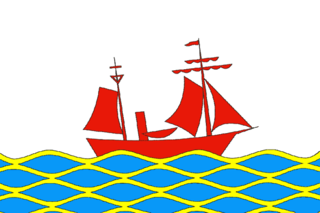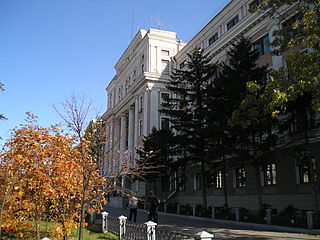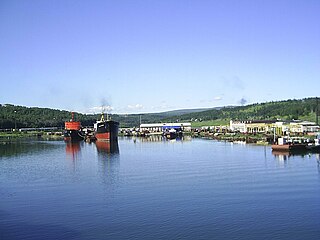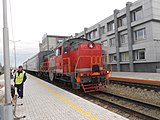
Sakhalin is an island in Northeast Asia. Its north coast lies 6.5 km (4.0 mi) off the southeastern coast of Khabarovsk Krai in Russia, while its southern tip lies 40 kilometres (25 mi) north of Japan's Hokkaido. An island of the West Pacific, Sakhalin divides the Sea of Okhotsk to its east from the Sea of Japan to its southwest. It is administered as part of Sakhalin Oblast and is the largest island of Russia, with an area of 72,492 square kilometres (27,989 sq mi). The island has a population of roughly 500,000, the majority of whom are Russians. The indigenous peoples of the island are the Ainu, Oroks, and Nivkhs, who are now present in very small numbers.

Strait of Tartary or Gulf of Tartary is a strait in the Pacific Ocean dividing the Russian island of Sakhalin from mainland Asia, connecting the Sea of Okhotsk on the north with the Sea of Japan on the south. It is 632 km (393 mi) long, 7–23 km (4.3–14.3 mi) wide, and only 4 m (13 ft) deep at its shallowest point.

Okha is a town and the administrative center of Okhinsky District of Sakhalin Oblast, Russia. Population: 23,008 (2010 Census); 27,963 (2002 Census); 36,104 (1989 Soviet census).

Sakhalin Oblast is a federal subject of Russia comprising the island of Sakhalin and the Kuril Islands in the Russian Far East. The oblast has an area of 87,100 square kilometers (33,600 sq mi). Its administrative center and largest city is Yuzhno-Sakhalinsk. As of the 2021 Census, the oblast has a population of 466,609.

Yuzhno-Sakhalinsk is a city and the administrative center of Sakhalin Oblast, Russia. It is located on Sakhalin Island in the Russian Far East, north of Japan. Gas and oil extraction as well as processing are amongst the main industries on the island. It was called Vladimirovka (Влади́мировка) from 1882 to 1905, then Toyohara during its period of Imperial Japanese control from 1905 to 1946. As of the 2010 Census, its population was 181,728.

Karafuto Agency, from 1943 Karafuto Prefecture, commonly known as South Sakhalin, was a part of the Empire of Japan on Sakhalin. It was part of the gaichi from 1907 to 1943 and later a prefecture as part of the naichi until 1945.

Kholmsk, known until 1946 as Maoka, is a port town and the administrative center of Kholmsky District of Sakhalin Oblast, Russia. It is located on the southwest coast of the Sakhalin Island, on coast of the gulf of Nevelsky in the Strait of Tartary of the Sea of Japan, 83 kilometers (52 mi) west of Yuzhno-Sakhalinsk. Population: 30,937 (2010 Census); 35,141 (2002 Census); 51,381 (1989 Soviet census).

Korsakov is a town and the administrative center of Korsakovsky District of Sakhalin Oblast, Russia. It is located 42 kilometers (26 mi) south from Yuzhno-Sakhalinsk, at the southern end of Sakhalin Island, on the coast of the Salmon Cove in the Aniva Bay. The town has a population of 33,526 as of the 2010 census.
Between 1905 and 1945, the Japanese Empire administered the southern half of Sakhalin, using the name Karafuto (樺太). The area was designated a chō (廳), the same term given to Hokkaidō at the time. It is commonly referred to as Karafuto Prefecture in English. The prefecture was divided into 4 subprefectures, which in turn were subdivided into 11 districts, in turn divided into 41 municipalities

Railways with a railway track gauge of 5 ft first appeared in the United Kingdom and the United States. This gauge became commonly known as "Russian gauge", because the government of the Russian Empire chose it in 1843. Former areas and states of the Empire have inherited this standard. However in 1970, Soviet Railways re-defined the gauge as 1,520 mm.

Poronaysk is a town and the administrative center of Poronaysky District of Sakhalin Oblast, Russia, located on the Poronay River 288 kilometers (179 mi) north of Yuzhno-Sakhalinsk. Population: 16,120 (2010 Census); 17,954 (2002 Census); 25,971 (1989 Soviet census).
Sakhalin Koreans are Russian citizens and residents of Korean descent living on Sakhalin Island, who can trace their roots to the immigrants from the Gyeongsang and Jeolla provinces of Korea during the late 1930s and early 1940s, the latter half of the Japanese ruling era.

The Sakhalin Tunnel is an incomplete and currently indefinitely postponed construction project, which after completion would have connected the island of Sakhalin with mainland Russia via a tunnel of approximately 10 kilometres (6 mi) under the Nevelskoy Strait.

The Sakhalin–Hokkaido Tunnel is a proposed connection to link the Russian island of Sakhalin with the Japanese island of Hokkaido. Cost estimates by Russia in the year 2000 put the project at $50 billion. When the project is complete, it will span across the Soya strait for 45-kilometre (28-mile), making it the longest bridge in the world.
Pogibi is a rural locality in Sakhalin Oblast, Russia. It is located at Cape Pogibi, the closest point on the island of Sakhalin to the Russian mainland, only 7.5 km across the Strait of Nevelskoy at this point.

Far Eastern Railway is a railway in Russia that crosses Primorsky Krai, Khabarovsk Krai, Amur Oblast, Jewish Autonomous Oblast, and Yakutia.

Tymovskoye is an urban locality and the administrative center of Tymovsky District of Sakhalin Oblast, Russia, located in the central part of the Sakhalin Island on the right bank of the Tym River, about 450 kilometers (280 mi) north of Yuzhno-Sakhalinsk. Population: 7,855 (2010 Census); 8,532 (2002 Census); 10,869 (1989 Soviet census).

The Soviet invasion of South Sakhalin, also known as the Battle of Sakhalin, was the Soviet invasion of the Japanese portion of Sakhalin Island known as Karafuto Prefecture. The invasion was part of the Soviet–Japanese War, a minor campaign in the Asian Theatre during Second World War.

The Vanino–Kholmsk train ferry is the ferry connection across the Strait of Tartary in Russia that connects Vanino in Khabarovsk Krai and Kholmsk in Sakhalin Oblast. This ferry connects Sakhalin Island with mainland Russia and its distance is 260 km. It is operated by Sakhalin Shipping Company.

Yuzhno-Sakhalinsk railway station is railway station of Sakhalin Railway in Yuzhno-Sakhalinsk, Sakhalin Oblast, Russia. The station belongs to the Far Eastern Railway.




























